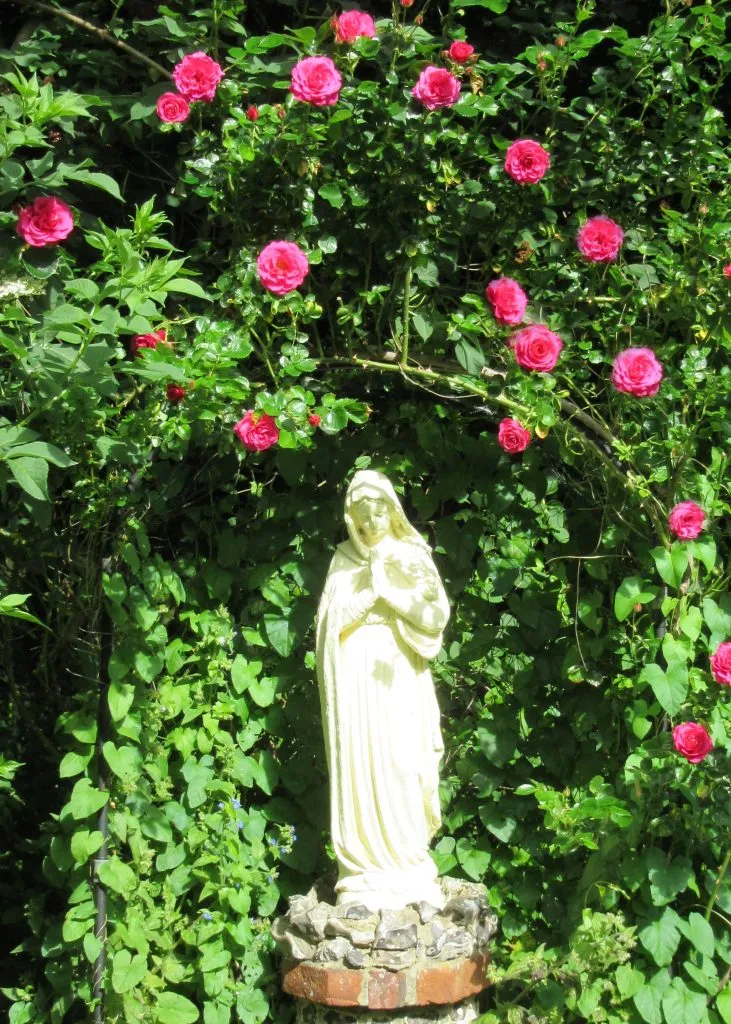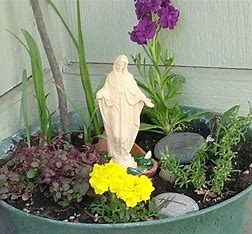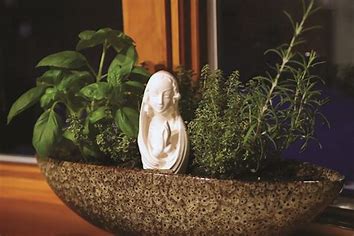The Legacy of Mary's Gardens: Nurturing Flora, Fauna, and Faith
- Admin
- Jun 27, 2024
- 6 min read
Read about the tradition of gardens dedicated to the Virgin Mary. Understanding this beautiful tradition within the context of the Laudato Si encyclical helps promote devotion to Mary through integral ecology.
- by Hazel Franco
Pope Francis' Laudato Si encyclical praises God's bountiful creation. The encyclical is named after the notable Canticle of Creation by St. Francis of Assisi. The canticle praises God through plants, flowers, animals, and all aspects of creation. One of the canticle verses included in the Laudato Si encyclical is "Praise be to you, my Lord, through our Sister, Mother Earth, who sustains and governs us, and who produces various fruit with colored flowers and herbs." Consequently, planting flora and fauna dedicated to the Virgin Mary is our expression of care for creation. In Catholic and Marian traditions, this closely relates to the promotion and dedication of Mary's Gardens.
What is Mary's Garden: Origins and Purpose
Mary's Garden, a place of serene beauty and tranquil respite, is a tribute to the Blessed Virgin Mary. This garden, adorned with a diverse array of flora, each with a Marian name or a connection to Mary, mirrors the many facets of her life and the virtues she embodies. These gardens beckon contemplation, prayer, and veneration of Mary, offering a peaceful sanctuary from the world.
At the heart of these gardens, a statue of Mary is often surrounded by blooms like lilies and roses, symbolizing her purity and divine grace. The selection of plants in Mary's Garden is intentional, with each plant carrying its emblematic significance. For instance, Lilies as Mary's purity, Roses for her status as the Queen of Heaven, Marigolds as "Mary's gold," and Lilies of the Valley as "Mary's Tears," which is believed to have emerged from the tears Mary wept at the foot of the cross. The planting of these typical plants serves as poignant symbols of Mary's sorrow and her heavenly glory, adding a layer of spiritual depth to these gardens.
Mary’s Gardens are deeply rooted within the sacred confines of European convents and monasteries of the seventh century. The earliest documented instance of such a garden can be traced back to St. Fiacre of Breuil, c. 600 – 670 AD, an herbal medicine connoisseur who migrated from Ireland to France. In his new homeland, he established an abode, cultivated a garden of vegetables and herbs, and founded a hospice for travelers. As a testament to his devotion, he dedicated a garden oratory to the Virgin Mary, marking the inception of the tradition of these gardens.
Embedded in the Christian tradition, these gardens served as educational landscapes where individuals could learn about faith through the language of plants and flowers, akin to how stained-glass windows narrated biblical tales. Embarking on the creation of Mary's Garden is a journey of spiritual significance. Whether nestled in a cozy nook of your garden or sprawling across a larger expanse, Mary's Garden creates a serene oasis that is a testament to beauty and tranquility.
Creating Mary’s Garden is an opportunity to foster a personal sanctuary, a space cherished for its aesthetic and peaceful ambiance, and a tangible expression of our spiritual connection. This venerable tradition has been lovingly preserved and adapted over the ages, culminating in contemporary sanctuaries of contemplation amidst the splendor of the natural world.
The Mary's Garden Movement in the US
The Mary’s Garden movement started in Philadelphia in 1951. American scholar and researcher John S. Stokes Jr. played a pivotal role in this movement, advocating for establishing Mary’s Gardens across the U.S. and restoring the Marian floral names. John Stokes' comprehensive archive, including personal documents, catalogs, and organizational records from Mary's Gardens, is preserved at the University of Dayton. The movement's origins in the US drew inspiration from a Mary’s Garden, founded in 1932 by Frances Crane Lillie in Woods Hole, Massachusetts. This garden sparked Stokes' initiative toward the movement. The movement has galvanized individuals and communities to cultivate their own Mary’s Gardens.
How to Create a Mary's Garden
Establishing Mary’s Garden can be a serene addition to any environment, regardless of size. Here's how to create one:
Any available space, from a small section of your yard to a more expansive area, can be transformed into a peaceful sanctuary. Traditionally, a statue of the Virgin Mary serves as the centerpiece; you can also choose towering plants such as lilies or roses to anchor your garden. Tailor the garden to fit your environment, whether it's a shaded nook or a sun-drenched spot, and it's even possible to arrange one on a balcony or patio for urban settings.
Emphasizing flexibility, the Mary's Garden movement suggests alternatives like Mary Dish Gardens or Container Gardens for those with space constraints.
Mary Dish Gardens are diminutive, sacred spaces crafted within the confines of a dish or bowl. These gardens are home to petite plants that carry spiritual meanings or are linked to the Virgin Mary, offering a condensed version of a traditional Mary's Garden for indoor reflection.
Container Gardens offer a flexible approach to gardening, utilizing an array of receptacles like pots, planters, or raised beds for plant cultivation. This method suits those with restricted outdoor areas or wanting to bring greenery indoors. Such gardens can host various plants, including ornamentals, herbs, and edibles, tailored to personal style and spatial limitations.
Establishing a garden dedicated to the Virgin Mary is a heartfelt tribute, and numerous plants with traditional ties to her can be incorporated. Consider these plants, each with its symbolic meaning and historical connection:
Roses – Dubbed the "queen of flowers," roses are deeply associated with Mary, embodying her love and immaculate virtues.
Lilies – Lilies are a classic choice because of their association with Mary's virginity, purity, and divine motherhood. Lilies have often been depicted in Annunciation art.
Marigolds – Referred to as "Mary's Gold," these blooms are believed to symbolize the precious offerings to Mary in lieu of money made by the devout. Marigolds also represent Mary's royalty and queenship.
Violets – Representing Mary's modesty, violets offer subtle beauty to your sacred space.
Columbines – Termed "Our Lady's Shoes," legend has it that these flowers emerged from the very spots touched by Mary during her visit to her cousin Elizabeth.
Forget-Me-Nots – These delightful blue blossoms are often seen as the "Eyes of Mary," providing her watchful gaze over believers.
Irises – Symbolizing Mary's sorrows, also known as "Sword Lilies" due to their blade-shaped leaves.
Strawberries – Celebrated as the "Fruitful Virgin," strawberries symbolize Mary's virtues and the spiritual rewards of faith.
MARIANA 1: A Compilation of Plants Linked to Christian Tradition
Click here to download a PDF version of the MARIANA 1
MARIANA 1 is one of the resources available in the John Stokes Jr. Collection in the University of Dayton database. MARIANA 1 is a comprehensive botanical listing cataloging over 600 plants with names or symbolism linked to Christian tradition, specifically to Christ, the Virgin Mary, angels, and saints. The title "MARIANA" reflects the Christian practice of attributing flowers to Mary, the "Flower of flowers," and refers to the century-old tradition of cultivating "Mary’s Gardens" filled with symbolic plants in honor of Mary, Hortus Conclusus, Latin for the "Garden Enclosed," a symbolic reference to her from the scriptures, specifically, from Song of Songs, 4:12. The compilation draws from various sources, including over 100 dictionaries, horticultural guides, folklore, and religious texts. In essence, MARIANA 1 bridges horticulture, history, and spirituality, fostering the creation and appreciation of gardens that celebrate the Virgin Mary's virtues and the beauty of nature. The John S. Stokes Jr. collection will be a valuable resource if you consider creating a Mary’s Garden.
Cultivating Soil and Soul in Mary's Garden
In the embrace of Mary's Garden, we find a reflection of the divine interplay between nature and spirituality. These gardens are not merely a collection of plants; they are a living tapestry of faith and a testament to the enduring legacy of Marian devotion. As we tend to each bloom and leaf, we engage in silent prayer that honors the sanctity of creation and the Virgin Mary, who stands as a symbol of nurturing love and grace. In cultivating these sacred spaces, we are reminded of our responsibility to care for our common home, Earth, and to cherish the beauty that abounds within it. Mary's Garden is more than a sanctuary; it is a call to action, urging us to sow seeds of hope and stewardship for the world, just as we would for the most cherished garden. Let us carry forward this tradition with reverence, cultivating soil and soul, ensuring that the essence of Mary's Garden—a harmonious blend of devotion, beauty, and ecological consciousness—continues to flourish for generations.
[To read more about the Marian and Christian names of plants, visit "All about Mary" or "John S. Stokes Jr. Collection" at udayton.edu]
Hazel Franco © 2024
Below are images of various styles of Mary's Gardens – within yards, open spaces, patios, and homes. The last four images are of Mary's Gardens in the indoor style, including a miniature Mary's Garden (last image).
This article is dedicated to my mother, Bertille, on her first death anniversary, June 28; she inspired me to love and care for flowers, plants, and our natural surroundings and grow in my love for Mary.























